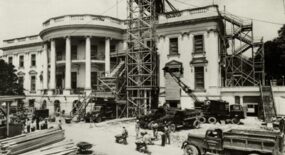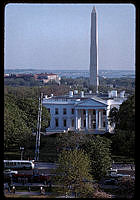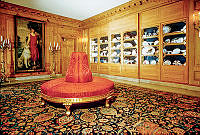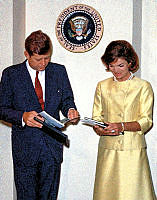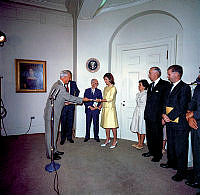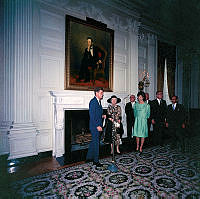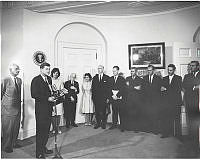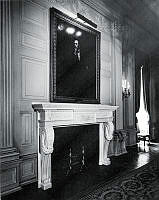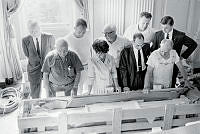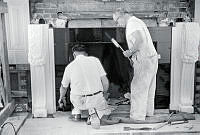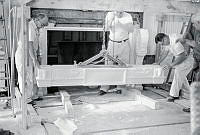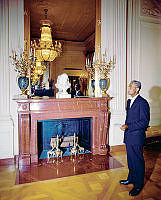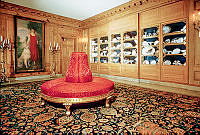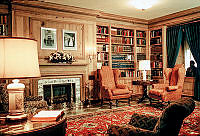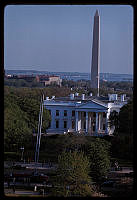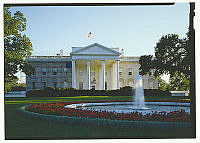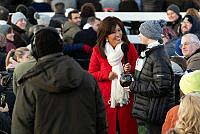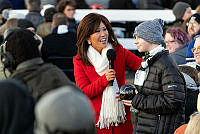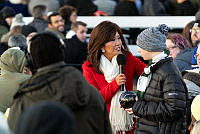Making Religion Fashionable
Benjamin Henry Latrobe and St. John's Church
Copyright © Spring 2010 White House Historical Association. All rights reserved under international copyright conventions. No part of this article may be reproduced or utilized in any form or by any means, electronic or mechanical, including photocopying, recording, or by any information storage and retrieval system, without permission in writing from the publisher. Requests for reprint permissions should be addressed to books@whha.org

Latrobe, presentation perspective of Saint John’s Church from the southwest, probably mid-1815.
Maryland Historical SocietySaint John’s Episcopal Church on President’s Square pleased its architect, Benjamin Henry Latrobe, almost to excess. Trained in England, Latrobe (1764–1820) immigrated to the United States in 1796 impassioned with republican ideals. He became the first American architect of truly international stature, and he struggled to introduce the architectural profession to the new democratic republic. He worked on many of its most important buildings, including the White House and the U.S. Capitol. In a career filled with frustrations, the little church seemed a rare, trouble-free project and one of which he was extremely proud.
In 1815, Latrobe wrote to his 22-year-old son Henry: “I have . . . built a Church on President’s square, a smart thing enough, at which the natives stare exceedingly, because it does not in the least resemble a barn, but has the form of a Cross and is covered with a dome.”1 In his usual witty and condescending way, Latrobe implied that most other buildings in Washington, if not America, were little better than barns.
Latrobe trained his talented son Henry in architecture and engineering and frequently confided in him as one designer to another. In December 1816, he again wrote: “St. John’s Church, which I have built is a pretty thing, and has a celebrity beyond all bounds. It has made people religious who were never before at church.”2 Finally, in a third letter to Henry in June 1817, after the completion of Saint John’s, Latrobe enthused: “The little church I have built has made religion fashionable, and a very eloquent, and highly respectable Clergyman, Mr. Hawley, will I believe, do more, and make devotion sincere. The style of the church [is] extremely simple, but out of the usual track of form internally and externally gains daily more approbation.” In this letter, Latrobe drew two small sketches of the church, showing a schematic plan and an elevation.3

Small sketches of Saint John’s Church included in a letter from Benjamin Henry Latrobe to his son Henry, June 4, 1817.
Maryland Historical SocietyPleased as Latrobe seemed with the design of Saint John’s, his letters to his son did, in fact, gloss over some problems in its design and construction. Indeed, when he sketched the church for Henry in 1817, he had already made functional compromises in the design that diluted its ideal geometries. Significantly, he did not include these in the little sketches. Also, like many of Latrobe’s buildings (those few which survive), Saint John’s has undergone numerous alterations, so that to understand Latrobe’s original designs requires some application.
Latrobe’s sketches represent the essentials of his design: the plan contains a circle, representing both a circular balcony, or gallery, and a shallow dome above it; the circle occurs within an implied central square, with four short arms extending from it, forming an equilateral, cruciform plan known as a Greek Cross. For its geometric beauty and clarity, the domed, Greek Cross church plan was a favorite of architects since the Renaissance, although it inevitably competed and often compromised with its less elegant cousin, the Latin Cross (or Roman Cross) plan, which, with its elongated nave axis and shorter chancel and transept (crossing arms), more easily accommodated practical functions such as seating and a traditional, processional liturgy.

Latrobe, “Plan of the Floor & Pews of St. John’s Church Washington. B. H. Latrobe Jany. 20th 1816.” Latrobe’s “divided” plan showing the layout of the pews on the left and the floor framing on the right. North is to the left of the plan.
Saint John's ChurchWhile architects preferred the Greek Cross, churchmen preferred the Latin Cross. Many notable churches of the Italian Renaissance, Saint Peter’s in Rome first among them, conceptually began their lives as Greek Cross plans but ended as Latin Cross plans.4 The eighteenth century Enlightenment, of which Latrobe was both a product and disciple, continued this enthusiasm for perfect geometries, expressive of a rational universe, ordered by a deity intent upon making his systems known to humans through science and mathematics. Like the many Renaissance churches that evolved from Greek to Latin Crosses, Saint John’s Church, too, eventually became a more traditional Latin Cross plan.Interestingly, Saint John’s is Latrobe’s only known Greek Cross church design. His other churches, although some had centralizing domes, such as the famous and recently restored Baltimore Cathedral (Roman Catholic, 1804–21), all had traditional, longitudinal plans.5 Perhaps he felt that the small size of Saint John’s, or the progressive character of its founders, warranted this more avant-garde form, and the church building committee proved adventurous enough to sanction it.6 As with many of Latrobe’s projects, several of his original drawings for Saint John’s are lost. His basic floor plan does not survive, and we can infer it only through two later drawings by him. The first is dated January 20, 1816, and is a “divided” plan, possibly intended for the carpenters, illustrating on the left Latrobe’s layout of the box pews and on the right a diagram for the framing and joists of the wooden platform floors he intended to be built under the pews. Also surviving is Latrobe’s plan for the gallery level of the church, with its pews, dated July 31, 1816. This plan also shows a small vestry room that Latrobe added to the east arm of the lower level of the church, inked in black. He evidently added it to the scheme at the request of the clients. This vestry room is also shown in elevation on the opposite side of this plan.

Latrobe, “Plan of the Galleries of St. John’s Church Washington July 31st 1816.” North is to the left of the plan. This plan also shows Latrobe’s vestry room added at ground level (top, or east, in black ink; bottom, in elevation).
Saint John's ChurchThese surviving drawings are so visually complex and difficult to understand that it is useful to reconstruct a more easily readable plan from them. It is a basic ground floor plan of the church showing its walls and the columns that support the circular gallery. In this plan, dashed lines represent elements overhead—a “reflected ceiling plan.” The dashed lines indicate the four segmental arches (i.e., segments of circles) that spring at ceiling level from piers at the inner corners of the central square, outlining the identical circles of the gallery and dome. Although the circular gallery was altered in a later remodeling, the arches (of plastered brick) and the shallow plaster and lath dome survive in the church today. The dome rests on four curving triangular pendentives (also of wood and plaster) that serve to mediate between the geometries of the circular dome and the square base and corner piers below it.
It is evident that during his design process, Latrobe began almost immediately to compromise his ideal Greek Cross scheme for Saint John’s. His sketch of 1817 to Henry Latrobe expressed his essential concept, or parti, in its purest form: a centralized plan fusing circle, square, and equilateral cross. Even before he sent these little sketches to his son, however, he had already diluted these ideal geometries to accommodate necessary church functions. As shown in his January 20, 1816, plan of the pews and floor framing, he had introduced fifty-two box pews on the ground floor (there were an additional thirty-two in the gallery, for a total of eighty-four). One senses from the drawing how hard Latrobe worked to force these somewhat awkward pews to conform to the innate geometries of the plan. The pews served not only the seating function but also defined circulation paths within the church. One path is circular, occurring immediately outside the perimeter of the columns that support the circular gallery; the other is a longitudinal axis from the western door to the eastern chancel and altar area. As an additional contextual accommodation, Latrobe designed a door in the southern arm of the church, facing the President’s House, creating a secondary lateral axis to acknowledge this important neighbor. This side entry, however, further disrupted the symmetries of the plan and the pews.

Ground floor plan of Saint John’s Church as Latrobe designed it, reconstructed from Latrobe’s surviving drawings.
Patrick Snadon and Thomas WilliamsLatrobe’s compact, centralized plan naturally emphasized the pulpit and with it the preaching function, whereas a longitudinal plan and its concomitant processional liturgy would have focused instead upon the eastern altar and its mysteries of transubstantiation and symbolic rebirth (for centuries, the western entrance of Christian churches had symbolized the setting sun and mortal death, while the longitudinal procession to the eastern altar symbolized the rising sun, divine rebirth, and immortal life). Ideally, in a centralized “preaching” or auditorium plan, the pulpit would have occupied the exact center of the space, under the dome, but this would have been impractical, for two reasons. First, it would have dispensed entirely with the altar (which, indeed, seventeenth- and early eighteenth-century Puritan meeting houses of New England had done). The Episcopalians, however, no matter how “low church,” never abandoned the altar entirely. Second, placing the pulpit at the exact center of the plan would have caused visual and acoustical problems for the half of the audience that the preacher could not face. Latrobe’s compromise at Saint John’s was to place a prominent, circular pulpit at the terminus of the short, eastern path created by the pews through the center of the church. Accounts tell us that the pulpit was of wood, in an elegant, wineglass shape, with a small spiral stair. Behind this pulpit, in the shallow eastern arm of the cross, Latrobe placed the altar. Because the central pulpit concealed the altar, Latrobe resorted to one of the mechanical contrivances with which he not infrequently attempted to reconcile such conflicting programmatic requirements: he placed the altar on metal wheels anchored to an iron track in the floor so that when the sermon was done, the pulpit could roll aside, revealing the altar. The drawback of this device was, that when not securely fastened to the floor, the pulpit exhibited a proclivity to roll away with any rector who preached too vigorously. It was replaced in 1842 with a fixed, side pulpit.7
In yet another compromise to his perfect Greek Cross plan, Latrobe found himself forced—presumably by the building committee—to add the small vestry room, mentioned earlier, to the church. His plan drawing of January 1816 does not indicate this space, but by the time of his gallery plan of July 1816, it had appeared. This new space did not fit comfortably within the body of the church—so Latrobe “added” it onto the east end behind the chancel and altar, an addition that marred the perfect geometry of the exterior. Latrobe’s gallery plan shows this vestry room in black ink on the east; in the margin of the drawing on the west side he drew it in partial elevation, as a little, gable-roofed protruding room. In one function that did easily accommodate itself to the symmetry of the plan, four stoves occupied the interior corners of the central space. The stoves were presumably wood stoves, though the accounts do not specify. Their locations are represented in his plan by four circles at the corners of the interior square.

Interior view of Saint John’s Church with Latrobe’s surviving arches, pendentives, and dome (galleries altered).
White House Historical AssociationIf the design of Saint John’s was diluted to a certain degree by necessary functions, the ceiling, with its arches, pendentives, and shallow dome, restored the perfect centralizing geometry of the interior—as it still does today, despite numerous later modifications. Pure white sunlight enhanced the rational character of the space. The cupola atop the roof admitted light through an oculus in the dome, and giant, half-round windows in each of the four arms of the cross flooded the gallery with light. Further light was admitted on the upper and lower levels through rectangular windows in the interior angles of the cross.
Latrobe’s handsome, stuccoed brick exterior reflected these internal arrangements. Four gable-roofed and pedimented extensions projected from a central cube, capped by a low, pyramidal hipped roof crowned by the cupola. The gallery floor expressed itself on the exterior through a thin belt course that encircled the building and acted as the springline for the great, arched windows. The church had no exterior columns or order, but a projecting cornice with exposed beam ends gave it a simple, “Tuscan” flavor.8

Latrobe, drawing labeled “St. John’s Church in the city of Washington, with the President’s house as it appeared in 1816, when the church was built,” c. 1816. This view shows Saint John’s from the northwest, with the burned-out President's House behind it to the south in the process of being rebuilt after the War of 1812.
Saint John's ChurchSaint John’s original exterior appearance is represented in three surviving drawings by Latrobe—perhaps another testimony of his fondness for it. The first, an early presentation perspective of c. mid-1815, illustrates the church from the southwest, showing both the principal western entrance and the southern door toward the President’s House (top image in article). The second view, probably done in c. 1816, after the church’s completion, shows it from the northwest with the shell of the President’s House (burned by the British in 1814) behind it to the south. The third view is in an 1817 drawing showing the south elevation of the President’s House (redrawn and updated by Latrobe from an earlier, 1807 drawing, in which the architect and then-President Thomas Jefferson had proposed the addition of a new south portico and lateral, colonnaded wings to the house). In the 1817 revision of the 1807 view, Latrobe added the by-then-completed Saint John’s Church over the right-hand, or east, wing of the President’s House.9
Construction of Saint John’s proceeded smoothly from September 1815 through its opening on October 27, 1816, and its consecration on Saint John’s Day, December 27, 1816. Latrobe’s principal bricklayer and plasterer was Peter Morte, and the carpenter was Richard Skinner, who accepted a position as church sexton. The total cost of the church was about $13,000, a very reasonable sum. Latrobe, as was usual with him, charged no fees for designing churches; he declined the offer of a free pew in the church but accepted an inscribed silver goblet, given in gratitude for his services. Latrobe, himself an amateur musician, composed a hymn for the dedication of the church and served for a time as its choirmaster and organist.10

Latrobe, drawing labeled “Elevation of the South front of the President’s house, copied from the design as proposed to be altered in 1807,” 1817. Saint John’s Church appears over the right-hand, or east, wing.
Library of CongressUpon its completion in 1816, Saint John’s offered the choice of a pew to then-President James Madison. He instead directed the vestry to choose for him, and it selected pew number 28 (subsequently number 54), thereafter reserved for him and his successors in the White House. The next five presidents attended Saint John’s (and many more over the decades), and it became known as the “Church of the Presidents.”11 Despite the relative effortlessness of its construction and the prestige of its location, however, Saint John’s found itself in difficulties. Early pew sales and rentals proceeded slowly, falling below the sum needed to run the church and clear its debt.12 The building was also cold in the winter. Latrobe had designed wooden floors in order to raise the pews a step above the brick aisles, but the building committee had evidently left them out as a measure of economy, and the four corner stoves proved insufficient to counter the chilling effect of the all-brick floors.13
In 1820, however, with attendance finally increasing, the vestry decided to risk spending an additional $3,500 in a major extension of the nave to the west, thereby transforming the church into a more conservative Latin Cross plan. This would add fifty new pews (returning more income), an entrance portico of six Tuscan columns, and a bell tower. A tradition suggests that Latrobe had left a plan for such an enlargement.14 The architect sometimes gave his clients design alternatives, and it is possible that he did leave drawings for this elongated scheme.15 No drawings survive for this Latin Cross extension, however, and Latrobe's authorship of it is problematic. By this time, he had removed to Louisiana, where he died in 1820 of malaria while supervising construction of the New Orleans waterworks. If the extension resulted from drawings left by Latrobe, it was surely garbled in execution. While the new flank windows, belt course, and the front door echo Latrobe’s original church of 1816, and the Tuscan-columned stone portico has a certain monumentality, the central bell tower is of wooden construction and of an old-fashioned, multistage Georgian formula that would have been anathema to Latrobe.
The church apparently also approached architect Charles Bulfinch about the extension.16 Bulfinch had, in 1817, succeeded Latrobe as architect of the U.S. Capitol Building. A competent architect, Bulfinch was significantly less talented than Latrobe. When he inherited Latrobe’s office at the Capitol, he confided in a letter to his wife: “At the first view of [Latrobe’s] drawings, my courage almost failed me—they are beautifully executed, and the design is in the boldest stile.”17 Bulfinch went on to find fault with Latrobe’s designs and ultimately got along better with his congressional clients than his predecessor, but this first impression is revealing. Bulfinch could certainly have done a respectable emulation of Latrobe’s style at Saint John’s, as he did at the Capitol Building. But the wooden tower would have been retardataire even for Bulfinch. Construction of the extensions was supervised from 1820–22 by Colonel George Bomford, chief of the Army Ordnance Department.18 It seems possible that he might have used drawings by either Latrobe or Bulfinch (or have synthesized both), or that the tower may have been his own invention. Ultimately the vestry may have felt Latrobe’s building to have been too secular in appearance and desired the extruded nave, portico, and tower to make it look more like a traditional church.

Saint John’s Church from the southwest, with the new, extended western nave, tower, and portico, c. 1888.
Library of CongressLatrobe’s son, John H. B. Latrobe, implied that his father would never have sanctioned the extension, writing: “My father designed St. John’s Church, Washington, which was really a beautiful little thing in its day, before some dull fellow made a Roman Cross out of a Greek one, and stuck on a stupid nondescript portico and an abominable pretext for a tower. During one of my father’s absences for a few days from home, I made a copy of his drawings of the plan, elevation and section of the building, and when he came home surprised him with the exhibition of my work.”19 John H. B. Latrobe assisted his father on and off as a draftsman in 1817–18 and obviously knew the Saint John’s designs, so a certain weight must be given to his words. Whatever the merits of the extension and bell tower, the bell itself was cast in the foundry of Joseph Revere, the son and successor of Paul Revere. It is marked “Revere Boston 1822.”20
In 1842–43, need for additional seating and the continued chill of the brick floors prompted the church to replace the old box pews with narrow, low-backed bench-type seats set more closely together. Wooden flooring was installed a foot above the old brick floors, and a partial cellar was dug for new furnaces (replacing Latrobe’s stoves). Also in 1820–21, Latrobe’s original circular gallery and columns were removed. The subsequent galleries are still in place and run longitudinally down the sides of the church.21 Latrobe’s former pupil, Robert Mills, may have carried out these changes.22 Mills was then the federal architect and, from the 1830s through 1851, designed many of the most important edifices in Washington, including the Washington Monument, the Treasury Building, the General Post Office, and the Patent Office.
Further proposals for remodeling Saint John’s continued to arise, mostly aimed at increasing its size and convenience. In 1866–69, three separate schemes were put forward, one of them by General Montgomery Meigs, the army engineer responsible for construction of the new dome and wings of the Capitol Building in the 1850s–60s. In 1874, the church engaged Washington architect T. S. Cheville to prepare a vast Romanesque Revival scheme with multiple towers that proposed to wholly obliterate the 1822 portico and steeple and would have engulfed Latrobe’s original structure. An economic downturn saved Saint John’s from this extreme makeover.23

Saint John’s Church, c. 1890s, showing the addition of the north and south staircase wings. Buckingham House, now the Saint John’s Parish House, is behind the church to the east.
Library of CongressSeating at Saint John’s continued to be in short supply and, in 1881–83, New York architect James Renwick was commissioned to remodel and extend the church. One of the notable architects of Victorian America, Renwick had designed the Gothic Revival Grace Episcopal Church (1843–47) and Saint Patrick’s Cathedral (1858–79 and 1885–88) in New York City. In Washington, he had built the red sandstone Smithsonian “Castle” (1847–55) and the French Second Empire–style Renwick Gallery, originally the Corcoran Gallery of Art (1859–61 and 1870–71). Renwick enlarged Saint John’s by extending the chancel to the east, with a new altar, which created more seating in the eastern end; he also added an organ room north of the new chancel, creating further seating in the gallery where the organ had previously been. Beyond the organ room was a new robing room; above that was a study for the rector. South of the chancel Renwick added a room with a canted bay to contain chairs for those who wished to hire single seats. He also added a new south entrance at this time.24 These extensions increased the capacity of the church by 180 “seatings,” to a total of 780. Despite Renwick’s reputation as an eclectic architect who worked in a variety of Victorian styles, he kept his additions to Saint John’s quiet and unobtrusive, echoing Latrobe’s simple classical forms. A final addition occurred when, between c. 1888 and 1900, two new wings housing symmetrical staircases to the galleries were added flanking the entrance vestibule on the north and south, just behind the portico. A redrawn plan shows the church as it was in c. 1900, with all these cumulative additions.
The pace of change at Saint John’s slowed in the twentieth century. In 1919–20, the famous New York architectural firm of McKim, Mead & White, which had remodeled, extended, and “restored” the White House in 1902, was employed to remodel Saint John’s. The architects swept away Renwick’s dark, Victorian interior colors, replacing them with chaste neoclassical monochromes and delicate, gilded plaster ornaments in a revived “Federal” taste. They cut new upper and lower windows in Latrobe’s only remaining exterior walls, on the north and south, which perhaps weakened the walls, as they then strengthened them with little corner buttresses topped with Renaissance-style volutes.25

Present-day view of St. John’s from H Street on the southeast. Only the central portion of the church is original to Latrobe; the eastern and western extensions are later.
The White House Historical AssociationIn the 1950s, the church received structural reinforcement and also acquired the adjacent Buckingham House, which faced on H Street behind the church.26 It became Saint John’s Parish House and was linked to the church on the east. In 1961, Saint John’s became a National Historic Landmark, and its congregation perhaps began to perceive it as a historic monument rather than the living, changing building it had been throughout the nineteenth century. Few alterations have occurred since that time.
One might be tempted to regret the multiple modifications to Latrobe’s delightful little church of 1815–16. But most of Latrobe’s surviving buildings have changed just as radically over time, and, in its alterations, Saint John’s has acquired an extraordinary genealogy, having associations with many famous American architects, including not only Latrobe but Charles Bulfinch, Robert Mills, James Renwick, and McKim, Mead & White. Few American buildings—perhaps none of this size—have such a distinguished architectural pedigree. From the exterior, the remains of Latrobe’s little cube-and-cruciform church survive, while inside, at the central crossing of the plan, one may look up into the shallow dome, resting on its original piers, arches, and pendentives, and sense that Latrobe’s elegantly austere geometries still give the space its dominant character.

Present-day view of interior. The central piers, arches, and dome are Latrobe’s (1815–17), while the extended nave (left), rebuilt balconies, some additional windows, and the stained glass all date from later remodelings.
The White House Historical Association







